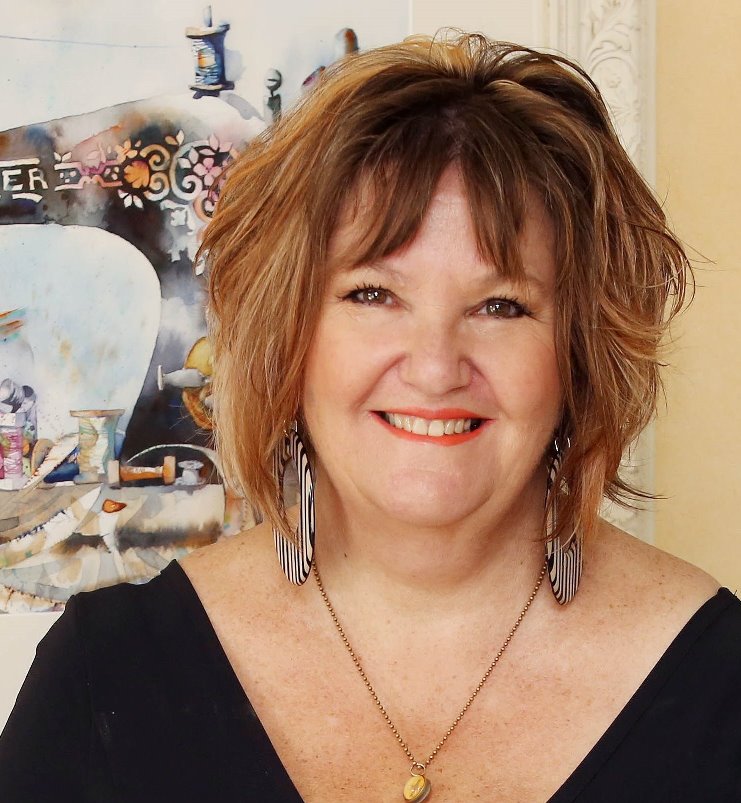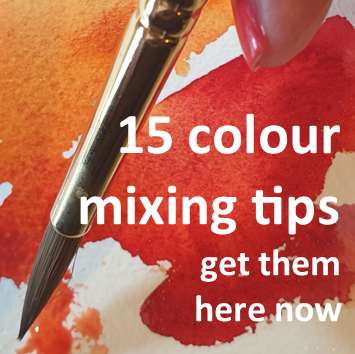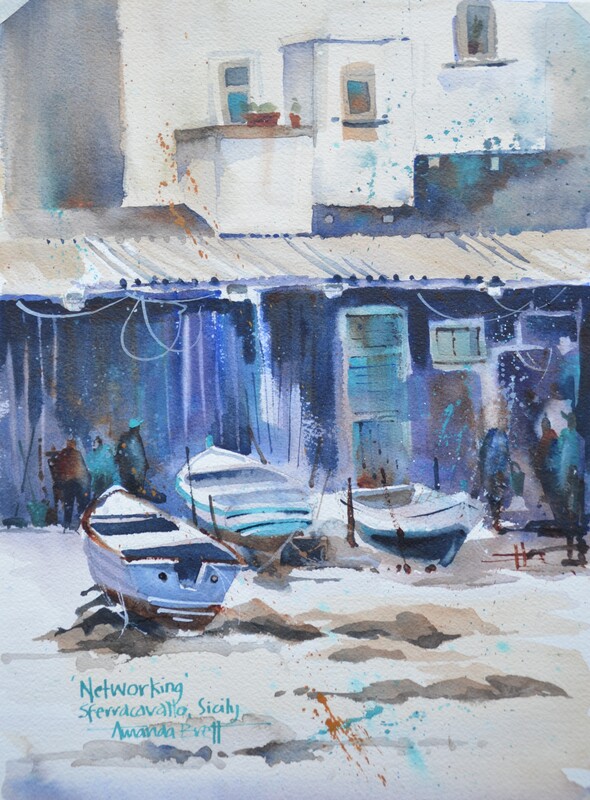 Networking, Sferracavallo Sicily Networking, Sferracavallo Sicily
I get many emails and questions about my palette, ie, the colours I have selected.
It took me a long time to get to this palette but once I decided it was an obvious choice. For what seemed an interminable length of time, I was on a continual search – what colour for this? What colour for that? In the end (really it was a new beginning) I selected transparent primaries that would allow me to mix super rich darks and any other colour, cool, warm – whatever I would need! My current foundation palette is made up of 3 transparent primaries plus Burnt Sienna (my most favourite colour and pigment). On my palette is Permanent Alizarin Crimson, Winsor Blue (Red Shade) and Quinacridone gold. Another primary triad I keep on my palette is Winsor Blue (green shade), Permanent rose and raw sienna. Temper this info in that I mostly use quinacridone gold and burnt sienna for mixing greens and neutralising. All these colours work beautifully together mixing secondaries and other cool or warm versions. Sometimes I dip into other workhorse pigments including French Ultramarine, Winsor Green, Yellow Ochre, Indian Yellow and cobalt blue. Avoid dependency on online colour "recipes", much of the fun in painting is playing with your colours and making your own discoveries everyday. Further this play will set you up for learning your likes and dislikes (eg colour, pigment, medium and paper etc) and lead you to your own process of creativity. I always start my day playing with colour which leads me into inspiration and more creative sessions. To be truthful, going to the art shop is like going to the candy store … so hard to resist all those amazing colours!! Further, its even harder to resist sets of colour! However, I find a set of colours is like buying an eyeshadow palette, half of which I won’t use. In the long run it’s better and more economical to choose a foundation palette of good quality transparent primaries plus a couple of “exotics” to make yourself happy!! See my vlog #129 As always, I am very grateful for every thumbs up, so please click below if you liked this article. I’d also love to read any comments on this theme, so let me know your thoughts below. Ciao cari pittori
0 Comments
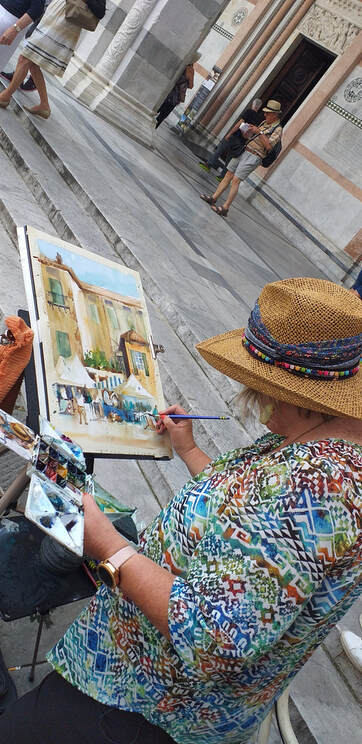
There’s nothing easy about painting watercolour en plein air but, for me, it is an exhilarating and fun experience.
My early attempts, however, were difficult and my paintings absolutely atrocious! It seemed to take me forever to get to grips with this new style of painting in the great outdoors. Without realising, I was faithfully following the 80/20 rule, 80% observation 20% drawing /painting. Later it dawned on me: this rule does not apply to painting watercolour en plein air - I was trying to follow a guideline for the constant situation of studio/observational drawing. When painting in the field, from the time you select your subject to your end-game, you have about 1-1.5 hours, 2 hours at most, to capture the subject before light and atmospheric conditions change too much. No mean feat but, if you practice, you will improve every time. Another element to consider is the subject. My first attempts at painting en plein air were with groups of artists who love painting landscapes. For me, it was a big problem. Although I love good quality landscape paintings, I’m not interested in painting them myself. I’m a city girl afterall, I’m attuned to light and shadows bouncing around architecture and the people who inhabit amazing spaces. Just think of Lisa Douglas (Eva Gabor) and you'll have hit your nail on the head! I often tell my students to slow their painting process down but in the case of painting watercolour en plein air, I’m going to contradict myself and tell you to speed up! Speed up so you catch the light and changing conditions, Remember, watercolour is a fast medium. Give yourself 5 minutes, and only 5 minutes, to take photos and sketch 1 or 2 value thumbnails and most importantly, take a mental snapshot. Make your memory work for you and, even if you think your result is "wrong", your work will be formed of the essence of your subject. Perfetto!! What a great excuse to go out and paint it again!! Your next work at the same scene will include different features and details and the next different again. My personal strategy is to map the subject onto my watercolour paper with a 5 minute sketch and then not refer to the actual scene again, even if I have to turn away from it. I am painting my interpretation of the scene not a photograph. Changing light and shadows become mighty confusing and create confusing paintings. Learn the tools you need to assist you:
x 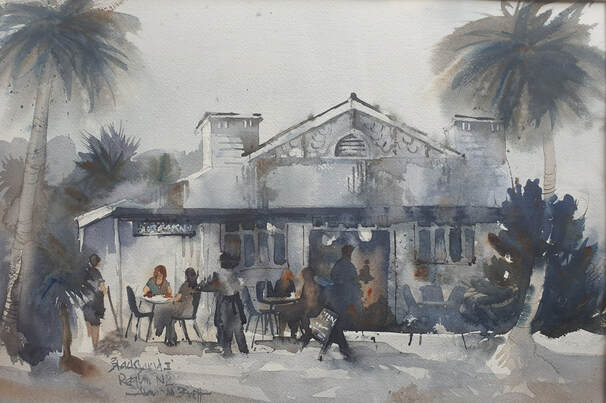 Blacksand, painted en plein air in Raglan NZ. Available from Splash 2022, Wellington NZ Blacksand, painted en plein air in Raglan NZ. Available from Splash 2022, Wellington NZ
A key issue for any artist is creating a focal point.
Have you ever asked yourself "Where should I start?" or "What's my story?" This is where your story is and where you want your viewers to look. Everything else is background. There are many ways to achieve this, my favourite is to divide my painting surface into thirds vertically and horizontally, aka the golden section, then use one of intersections for my focal point. This means that (unless your painting is square) your focal point will be unequal distance from any edge of your substrate, creating a discordance, a little bit of a shock – why isn’t it equal? It just feels like the natural spot! Many students ask me “where should I start?”. It doesn’t really matter except that, especially for beginners, a good place to start your painting is at the place that’s most exciting for you, the thing that got you interested, then build a background around it. This ensures you keep the background in the background and your focal area is full of exciting stuff and further, you’re enjoying what piqued your interest to start with. A focal point is also discussed as “your story”. Again I’m often asked “what do they mean, what is my story?” It doesn't have to be anything deep, dark and meaningful unless that's what you want to communicate. Your story is a description of what inspired you to paint: Eg I like the way the light hit the tablecloth and refracted through a glass of drinking water, making a super bright highlight on a pear and beautiful light and shadow shapes that danced over the folds of a tea towel. Write this in your sketch/notebook with your sketches, to keep your memory alive. This is a good habit for several reasons, but first of all, it aids your thinking processes; further, it’s your evidence of originality and your body of work and even more, galleries may ask you for descriptions; when stressed over preparing for shows the last thing you want to do is have to write descriptors – your early writings hold the key to your original inspiration. Along with your drawings, sketches and composition thumbnails, it is a good idea to write a list of accompaniments so you’re not stuck for ideas and feel forced to finish without having thought through thoroughly (crikey!) before you started. For example a table top painting might also include a vase and flowers, a suggestion of a chair, bottle of tomato sauce, a lemon and a spoon. In the background: light though a window, painting on the wall, books on a bookshelf and a table lamp. Once you have given your focal area a good start you can then move on to painting other areas of the painting and adjust and balance the painting later. It really all comes down to planning and understanding what you want to paint and why. Asking yourself these questions will help you to get to the heart of the matter quickly, help you to focus your concentration and get to picking up that brush sooner!! do feel free to comment or ask a question! ciao cari pittori!! |
AuthorPaintBox Tips, secrets, random thoughts, Poetry in watercolour is made in the freedom of the here and now. Amanda Brett Inspiration exists, but it has to find you working - Pablo Picasso There are no mistakes in watercolour, just some extra surprises!! Categories
All
What my readers and viewers have to say
Your emails are so informative! I must confess I've watched a couple of your demos from beginning to end, and it makes me want to watercolor!!! I've only ever painted with oil or acrylics and haven't know how to begin with WC. Your content is excellent!
Susan VN Hi Amanda
Thank you for your tips. They inspired me to practise and I realised I haven’t been loading the brush properly. I learnt about adding more paint, and not water, to washes. In today’s tips I like the idea of painting with purpose. Your tips are very helpful. I very much appreciate receiving them. Elizabeth Hi Amanda I enjoyed your post and generous tips. Looked up Dan Burt I begin to see that you can colour any subject to give it pizazz so long as the tone and form is correct Certainly adding value now to my attempts Thanks heaps Annie
Yes very wise words. Agree with not fussing and agree with comments about good quality paint. Well written and inspirational as always. Cheers Janet xxxx Archives
July 2023
Copyright © 2022 All images and text on Amanda's blog and website are the the legal property of Amanda Brett and may not be reproduced without express permission from Amanda Brett or her authorised agent. Thank you for respecting her art and the livelihood of all artists.
|



